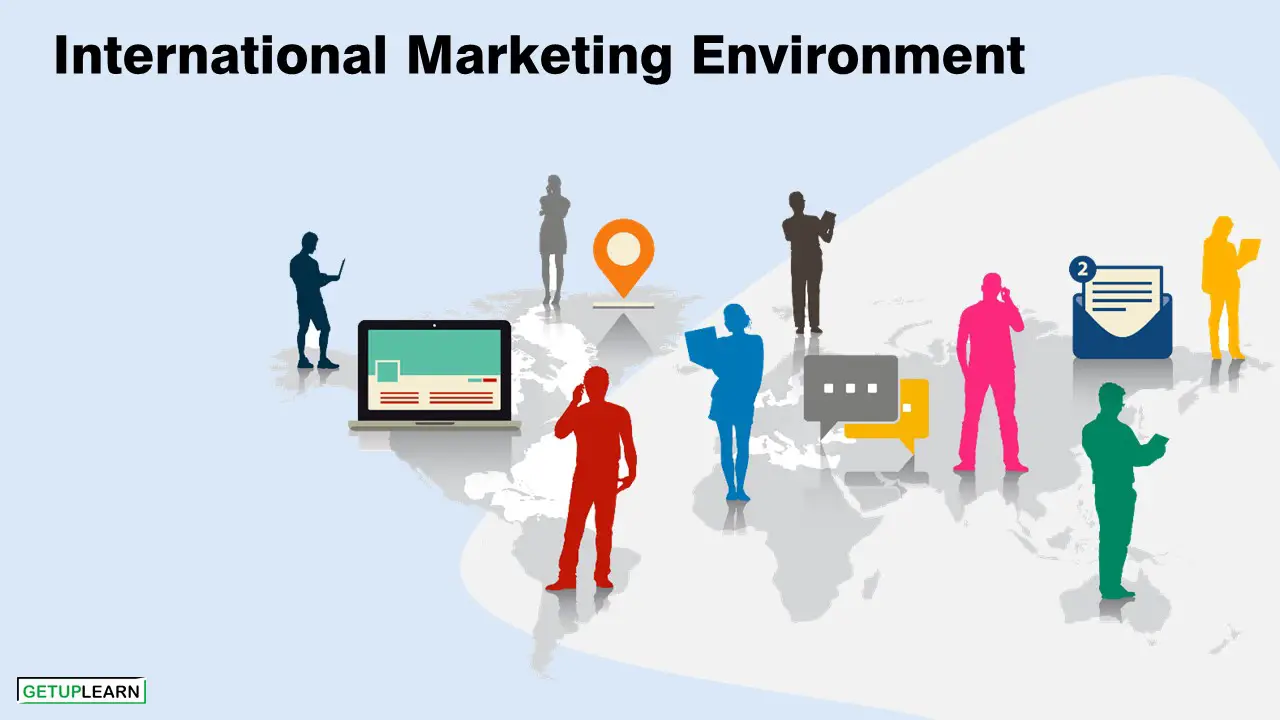Table of Contents
- 1 What is International Marketing?
- 2 What is International Marketing Environment?
- 3 Motives for International Business
- 4 Factors of International Marketing Environment
- 5 Political Environment
- 6 Political Systems
- 7 Legal and Regulatory Environment
- 8 Socio-Cultural Environment
- 9 Culture Affects Organizational Behavior
- 10 Culture and Perception
- 11 Subculture
- 12 Culture and Business
- 13 Economic Environment
- 14 Technological Environment
- 15 Global Market Challenges
- 16 FAQs Related to the International Marketing Environment
What is International Marketing?
International Marketing involves all the activities that form part of domestic marketing. An enterprise engaged in international marketing has to correctly identify, assess, and interpret the needs of overseas customers and carry out integrated marketing to satisfy those needs.
What is International Marketing Environment?
As the international marketing environment involves marketing across a firm‘s national boundaries, it has to confront varying legal, political, cultural, and sociological dimensions, which add many complexities to the task of marketing activities of the firm.
As international marketing management is the undertaking of marketing management activities and functions keeping in mind how to meet best the requirements of the customers of the countries to be served, this requires a detailed analysis of the likings and dislikes of the customers, the prevailing product classes and standards, etc.
Thus, the international marketing environment poses some new challenges in addition to the domestic marketing management challenges.
Motives for International Business
Business firms enter into international marketing only when they perceive some factors, which motivate them to do so. If there exist no motivational factors for a firm to enter into international marketing, the firm would rather prefer to remain domestic.
Most companies would prefer to remain domestic if their domestic market were large enough. Managers would not need to learn other languages and laws, deal with volatile currencies, face political and legal uncertainties, or redesign their products to suit different customer needs and expectations. By Kotler and Keller
Business would be easier and safer. Yet several factors are drawing more and more companies into the international arena.
From the above definition, it can be made out that it is not only the size of the domestic market that motivates the business firms to go into for international market but, besides this, there are some other factors also which create attractions for international marketing.
These are the following reasons motives for international business:
- Higher Profit Margins for Exports
- Under-Utilization of Capacity
- Economies of Scale
- Reduction of Dependence on One Market
- Export Obligation for Obtaining Imported Inputs
- Business Expansion
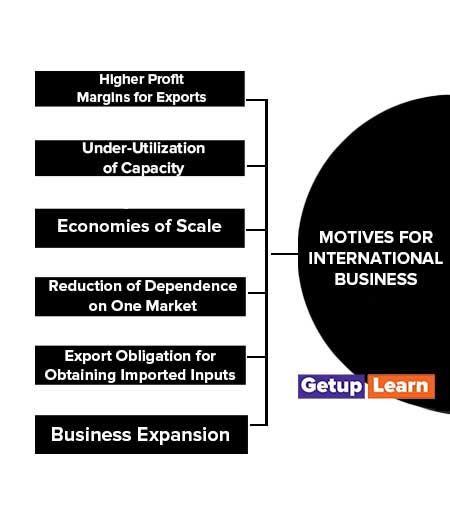
Higher Profit Margins for Exports
If the profit margins for exports are higher than in domestic sales, the firm may be attracted to export its produce than selling domestically.
Under-Utilization of Capacity
If the domestic sales are not sufficient enough to make the fullest utilization of the installed production capacity of the firm, then these firms seek export orders in order to fully utilize their production capacity.
Economies of Scale
Sometimes, business firms also undertake exports to attain economies of scale of production, as the additional production required for exports will result in the division of fixed costs over more units. Thus, this will bring in economies of scale, as the cost per piece will reduce.
Reduction of Dependence on One Market
International marketing is also undertaken in order to lower the risk involved while marketing is only domestically. Because in the domestic market, the demand may fall on account of local competition or some other factors. Foreign market sales may reduce these risks.
Export Obligation for Obtaining Imported Inputs
Sometimes, the government may impose export obligations on firms, which want to import some inputs of production. This is done in order to attain a balance of payments.
Business Expansion
Some firms undertake to export as an opportunity for business expansion as this way, the firms can expand their business and thus find new markets and hence more profits.
Factors of International Marketing Environment
Factors or forces concerned within the international selling setting will be classified into 3 classes as explicit within Figure 1. Managers handling international selling have to style their selling combine and selling (mix) ways in accordance with these forces.
He has got to keep in mind this and the expected impacts of such forces when making international selling choices. The setting determines the degree of advantageousness for any seller for international marketing; and determines the level of opportunities and threats.
Global Factors:
Such factors are related to the world economy. A broader image of worldwide development affects each choice of international selling. Main global factors include:
- Customer-related factors
- Political and legal factors
- Social factors iv. Cultural factors
- Competition
- World relations among nations and degree of worldwide peace.
- Geographic/ecological/climate-related factors
- Functioning of international organizations like UNO, World Bank, WTO, etc.
- Availableness of selling facilities and functioning of international agencies, etc.
Domestic Factors:
Domestic factors are associated with the economy of the state. Overall economic, social and cultural, demographic, political and legal, and other domestic aspects constitute the domestic environment for international marketing. This setting affects international selling combined in many ways.
The following are the factors of the international marketing environment:
- Political Environment
- Political Systems
- Legal and Regulatory Environment
- Socio-Cultural Environment
- Culture Affects Organizational Behavior
- Culture and Perception
- Subculture
- Culture and Business
- Economic Environment
- Technological Environment
- Global Market Challenges
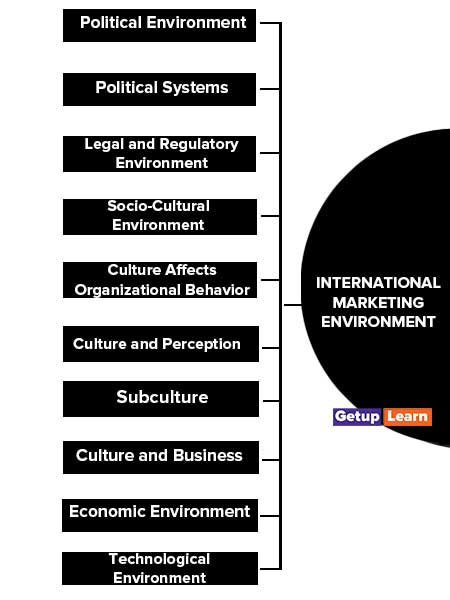
Political Environment
Political environments may range from a democratic system to communism with other variations between these ideological extremes. The political Environment is the state, government and its institutions and legislations, and the public and private stakeholders who operate and interact with or influence the system.
The political atmosphere should be good and very stable for a firm to operate successfully. The political environment forms the basis of the business environment in a country.
If the policies of government are stable and better then businesses would get impacted in a positive way and vice versa. In international construction, like in international business, one has to deal with governments as they are presently structured with all their diversity and even repressiveness.
Political Systems
As a firm ventures abroad, it’s to alter varied countries, each having its own political setup. Types of political systems: By and large, the communist or socialist form of government is not working in many countries, but the impact of socialism as a philosophy does persist.
There are countries like Pakistan, which follow a dictatorship style of government, whereas most countries in Europe and North America follow democracy. Even democracy has various forms such as the presidential type, as prevalent in the USA, or the parliamentary form of government, as in UK and India. Some countries in the Middle East have a typical theist political set- up, while others are secular countries.
In business, the form of government has a direct impact, because every sort of government has its own typical set of policies, programs, and priorities. These impact the countries’ regulatory mechanisms and the business has to comply with the laws of the land.
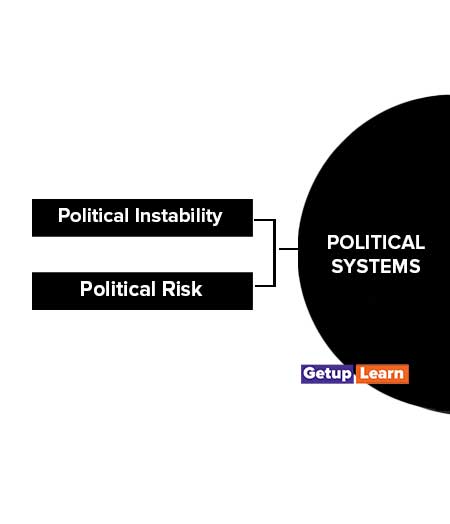
Political Instability
Despite diverse political systems, no system is bad if it works in a stable manner. The biggest problem arises when there is political instability. Some examples of political instability are:
- In Italy, over forty-five governments modified in fifty years.
- The last decade has seen fast changes in governments in Japan.
- India is passing through the ear of coalition governments.
- Pakistan had a military coup so a democracy, controlled by a military dictator.
- Afghanistan was under the rule of the fundamentalist Taliban so is heading towards an additional democratic setup.
- The Asian nation has seen an amendment in the regime, enforced by America.
- There are unit coups and genocides in African countries, Ethiopia, Eritrea, Congo, and many other African countries.
Political Risk
Although often correlated, political stability and political risk do not go together always. In the first three examples quoted within the on top of Para we discover that though the governments changed rapidly in India, Japan, and Italy, the basic policies of the government did not change.
Businesses had a sense of security while doing business in these countries. However, the war in Afghanistan and Iraq has had a tremendous impact on the business. Not many companies are taking the initiative of doing business in these countries.
They prefer to wait till normalcy returns. Political risk is more associated with the uncertainty and unpredictability of the political parties in power in a country. Basically, political risk depends on two factors:
- The willingness of a government to keep the situation under control.
- The ability of the government to keep the situation under control The careful analysis of the political system can greatly reduce the associated risks.
Analysis of political risk: Sundaram and Black have summarized the analysis of political risk in the form of the following points:
- Step 1
- Determine the critical economic/business issues relevant to the firm.
- Assess the relative importance of these issues.
- Step 2
- Determine the relevant political events.
- Determine the probability of occurring.
- Determine the cause-and-effect relationship.
- Determine the government’s ability and willingness to respond.
- Step 3
- Determine the initial impact of the probable scenarios.
- Determine the possible responses to the initial impacts.
- Determine the initial and ultimate political risk.
Legal and Regulatory Environment
Marketers must carefully study the legal and regulatory systems prevalent in the countries to avoid situations that might result in conflict, misunderstanding or outright violation of the laws of the foreign country.
Some of the important aspects, worth consideration, in the legal and regulatory environment, are:
- International Law
- Conflict of Laws
- Freedom of Contracts
- Patents and Trademarks
- Conflict Resolution
- Recourse
- Tariff Mechanism
- Equity Control
- Documentation and Formalities
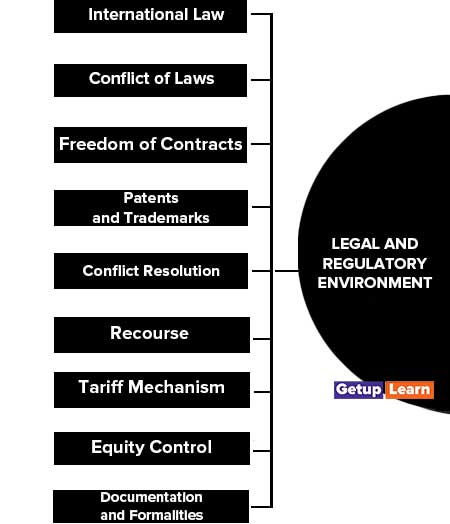
International Law
International law has existed since the sixteenth century, although, it has undergone a change in its form over the years. International bodies such as the UN, WTO, and regional groupings have been instrumental in developing international rules and regulations.
These international laws are ratified by the participating countries and are binding in nature. Hence, the business should perceive them properly to confirm compliance.
Conflict of Laws
Whereas doing business across nations, there can arise situations when the laws of two or more countries can be conflicting. Businessmen must go through these laws and put measures to avoid being caught in such a scenario.
For example, most of the countries of the Middle East want that the goods should be dispatched to them solely on those ships, which do not go to Israeli ports.
They ask for a certificate from the shipping line in this regard. If a businessperson ignores this law, he will be in an exceedingly very troublesome scenario and can incur heavy losses.
Freedom of Contracts
In developed countries and those which have a very sound legal system, the principles of the contract are taken for granted and are strictly enforced by law.
However, in some countries, the government interferes with these principles and may cause a loss to the businessman. One should be vigilant, especially while participating in global tenders or projects with long gestation periods.
Patents and Trademarks
Another important issue for a multinational corporation is the protection of its patents, trademarks, and intellectual property. Most companies invest heavily in research and development.
However, unscrupulous manufacturers in some developing countries take the advantage of the difference in the patent laws and manufacture a duplicate of the product, causing a heavy loss to the original manufacturer.
Companies, which have invested heavily in R&D should analyze these things and take protective measures. The issue has been addressed by WTO, which has instituted TRIPS (Trade Related Intellectual Property Rights) mechanism to avoid a loss to the initial manufacturers.
Conflict Resolution
it’s terribly troublesome to realize a perfect situation once there’s no conflict between the mercantilism partners. Conflicts can happen, but there has to be a known system of resolution of the conflicts.
There are sets of principles laid down for international arbitration. The businessmen must be aware of these and carefully analyze the devotion of the partners towards implementing them.
Besides arbitration, there are alternative mechanisms of dispute resolution developed by international bodies. Some of the international bodies, which have instituted mechanisms for international arbitration, are:
- (ICC) International Chamber of Commerce
- (AAA) American Arbitration Association
- (IACAC) Inter-American Commercial Arbitration Commission
- (ICSID) International Centre of Settlement of Investment Disputes
- Swedish Arbitration Institute
- (UNCITRAL) United Nations Conference on International Trade Law
Recourse
In the case of legal action, the operation of law can be terribly long and expensive procedure in several countries. If a country engages in long legal disputes in an exceedingly country, it tarnishes its image, besides incurring losses of time, money, and effort.
Tariff Mechanism
The tariff and taxation structure of the foreign countries must be clear to the business to avoid complications at a later stage. Although the tariff structures are being standardized for all the nations, still the differences exist and these must be carefully studied.
Equity Control
Different countries have different laws regarding the equity participation of foreign partners. In a few cases might allow 100% FDI in some sectors, whereas there might be limits on investment.
Some countries make the participation of a domestic partner obligatory. Such different situations must be carefully studied before taking any investment decision.
Documentation and Formalities
While most countries are dismantling the tariff barriers, they are yet to make the procedures easier and user-friendly. It is notable that China’s economic success story has a lot to do with the ease of doing business there.
There are little red tape’ and most of the regulatory requirements are cleared speedily. On the other hand, the business has to run from pillar to post to get approvals and the essential registrations for doing business in India.
A thorough knowledge of the prevailing system is crucial for fulfillment in an exceedingly foreign country.
Socio-Cultural Environment
Culture is the set of shared values of a society. It encompasses religion, language, customs, traditions and beliefs, tastes and preferences, social stratification, social institutions, buying and consumption habits, etc.
Culture Affects Organizational Behavior
It has several interfaces where it influences the business. Some of the important interfaces where culture affects business are Culture and organizational behavior: In their book on international management, Hodges and Luthans have identified the following points where culture affects organizational behavior:
- Centralized vs Decentralized Decision-Making
- Safety vs Risk
- Individual vs Cluster Reward
- High vs Low Organizational Loyalty
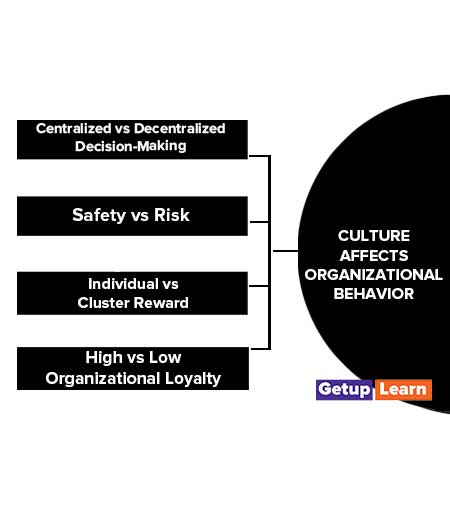
Centralized vs Decentralized Decision-Making
In some societies, all-important organizational decisions are made by the top management, while in others, the decisions are diffused throughout the organization.
For example, decision-making is highly decentralized in Japanese companies, while it is highly centralized in American firms. There are cultural reasons ascribed to this.
Safety vs Risk
The decision-makers in some organizations square measure disinclined to risk, while some take risks and thus make higher gains. The risk-bearing behavior of groups is also a cultural phenomenon.
This influences investment decisions at the organizational level and at the micro level of the consumers; it has an impact on buying habits. People who take risks buy new and innovative products, while others prefer to stick to tested products.
Individual vs Cluster Reward
In some societies, such as the Japanese, the reward got by a group is valued more than the individual reward, which is the order in American firms.
High vs Low Organizational Loyalty
Extrapolating the above point, societies with strong interpersonal ties have a high degree of structure loyalty, while those who value individual achievements have low organizational loyalty.
Culture and Perception
Culture contains a nice touching on how ever people view themselves and their surroundings, which influences their behavior. From the perspective of business, the manners in which people view the following are important:

Views of Themselves
Individuals lay variable degrees of importance on self-gratification. For example, in earlier times, people had a high degree of propensity to point out their splendor. Their consumption and spending behavior was towards extravaganza.
Nowadays, people are hard-pressed with resources and are driven by value while purchasing. Business needs to study the general trend of buying and take appropriate decisions.
Views of Others
A different trend from ‘I society’ to ‘our society is shown by the people at large. People feel the pain of others and offer a helping hand to them. The exploitative authoritative manner of business cannot be palled me in today’s paradigm.
Views of Organizations
Under the pressure of performance and other perks, workers as well as organizations have undergone a deep change in their relationships.
Employment is no longer for the whole lifetime and the organization is no longer perceived as the bread-giver. Such a shift in the relationship has its clash with the management of human resources in organizations.
Subculture
Within the culture, there exist several subcultures, which exhibit a similar influence on the business. A subculture is a variant of a culture. While it shares values and beliefs with the culture, it does modify it according to the specific requirements of the group.
For example, although people all over India share common values celebrate common festivals, and profess similar non secular beliefs, there are several variations at local levels.
Hindus of the geographic regions would follow completely different rituals from those in a geographical area or Madras. The marketer must understand the subculture as well while adapting to the local conditions.
Culture and Business
Culture can have a profound impact on business. The following examples will make this clearer:
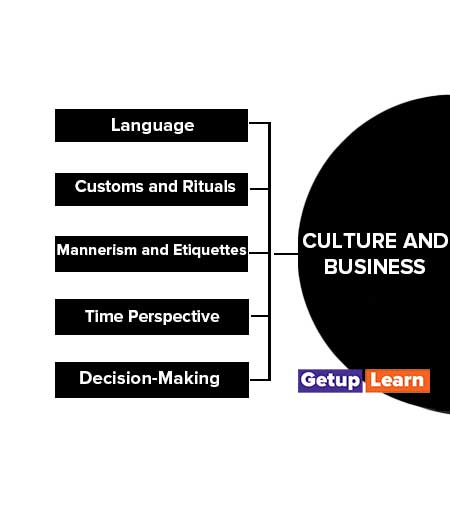
Language
Words acquire different meanings when spoken in different languages. So, the marketers have to understand the language of the host country and speak within the words understood by the people there.
An offensive marketing campaign can ruin the prospects of selling even the best products. A proper understanding of language will contribute heavily towards the success of any communication and negotiation of business.
Customs and Rituals
The knowledge of customs, rituals, festivals, etc. is important because people exhibit typical spending behavior at different times. For example, Hindus go on shopping for free throughout the Navratri and stop all necessary purchases throughout the shraddhas.
Muslims and Christians make heavy purchases during Ramzan and Christmas. A marketer can identify the right marketing opportunities and design the marketing strategy.
Mannerism and Etiquettes
The manners and etiquettes vary with culture and their information is vital when negotiating any deal with the customers.
Time Perspective
People have varying perceptions of time. Some cultures square measure terribly punctual and work quickly and cling to schedule, while others work with leisurely. The time perspective of the target country must be understood and the strategy designed accordingly.
Decision-Making
Culture has a profound impact on the decision-making behavior of people. While working in countries wherever deciding is slow, one must not push for decision and vice versa.
To arrive at the opinion, understanding culture is of essential importance for anyone desiring to achieve success in business in foreign lands. Although, the world is becoming global and there is a high degree of cultural diffusion, still, there is a need to adapt to the local environment, of which culture is an important constituent.
Economic Environment
The macro dimensions of “the backdrop is economic, social& cultural, political & legal & technological”. Each is important, but perhaps the single most immortal characteristic of the worldwide market surroundings is the economic dimension. With money, all things (well, almost all!) are possible.
Without money, several things are not possible for the merchandiser. Luxury products, for example, cannot be sold to low-income shoppers. Hypermarkets for food, furniture, or durables require a large base of shoppers with the flexibility to create giant purchases of goods and therefore the ability to run off with those purchases. Sophisticated industrial products require sophisticated industries as buyers.
Today, in distinction to any previous time in the history of the world, there is global economic growth. For the first time in the history of worldwide selling, markets in each region of the world area unit potential targets for pretty much each company from high tech to low technical school, across the spectrum of products from basic to splendor.
In reality, the fastest-growing markets, as we shall see, are in countries at earlier stages of development. The economic dimensions of this world market environment are of vital importance. This chapter examines the characteristics of the world economic environment from a marketing perspective.
The global market is fortunate in having a substantial body of data offered that charts the character of the surroundings on a country-by-country basis. Each country has national account data, indicating estimates of gross national product, gross domestic product, consumption, investment, government expenditures, and price levels.
Also available on a global basis are demographic data indicating the number of people, their distribution by age category, and rates of population growth. National accounts and demographic data do not exhaust the types of economic data available
Technological Environment
The technological atmosphere is probably the foremost dramatic force currently shaping our destiny. Technology has free such wonders as antibiotics, organ transplants, computers, and therefore the web.
It additionally has free such horrors as nuclear missiles, chemical weapons, and assault rifles. It has free such mixed blessings because of the automobile, television, and credit cards. New technologies create new markets and opportunities. However, every new technology replaces an older technology.
Transistors hurt the vacuum tube trade, picture-taking hurt the carbon paper business, the motorcar hurt the railroads, and compact disks hurt machine records. When previous industries fought or unnoticed new technologies, their businesses declined. Thus, marketers should watch the technological environment closely.
Companies that don’t carry on with technological amendment before long can notice their merchandise is out-of-date. And they can miss new products and market opportunities. The level of technology in countries differs and is related to their economic development.
Most technically advanced nations have research and development (R&D) organizations in many fields in place. Most of the developing nations either resort to buying advanced technology products from the nations possessing them or buy the technology from them.
In India, such technology transfers or purchases from different countries have been in vogue for the last 50 years. The problems that firms buying technology face are:
- Mostly old or outdated technology is sold to avoid direct competition.
- The manufacturing equipment sold with the technology is usually sold at jacked-up prices.
- At times even used or reconditioned equipment has been sold.
- There is pressure on the firms buying the technology to purchase completely built units (CBUs) and semi-knocked down (SKD) units, of the product under technology transfer for a period of time or for a given number of units.
This has resulted in firms going for reverse engineering of the product, where they buy a few pieces of the product from a number of international firms; cannibalize the products to see how they are inside and how they can be assembled locally.
For this reason, it has been accepted by most firms owning technology that they cannot hold on to the technology on an exclusive basis in the rapidly changing business environment in the midst of an information blitz.
Global Market Challenges
The Global Market Challenges acknowledge 5 key problems that inhibit growth within the international economy and, if addressed, are important factors to extend equality and opportunities: little Business Reformation, Global Trade Barriers, Education unskillful, Environmental Challenges, and Gender difference.
In scripting this, we have a tendency to aim not solely to boost awareness of those crucial problems, but conjointly propose strategic policy recommendations so the international community i.e. private & Public, can focus resources on tangible and actionable initiatives.
The following area unit the recommendations reached by North American nations in numerous aspects:
- Small Business and Cooperation
- Global Trade Barriers
- Education
- Environmental Challenges
- Gender Inequality

Small Business and Cooperation
Small and medium enterprises are unit important economic and social levers with the target to higher integrate and develop their potential during a globalized economy; we have a tendency to propose 2 recommendations:
- Establish programs to support native businesses, with a, read not solely to profit but conjointly with the goal of determining social issues. Promote the utilization of native and regional resources to assist the event of communities.
Commit to expanding on the platform of investment “crowd-funding” to create democratic and wide-reaching access to information and capital. - Foster the expansion and development of little and medium enterprises inside countries by providing support for programs like low-interest loans, facilitating network building (e.g. centralized services to advise, mentor, and promote SMEs), and economic clusters.
Global Trade Barriers
In a shot to encourage globalized trade, enhance participation and stimulate economic growth, the committee recognizes the need for increased innovation and decreased trade barriers while still ensuring an equitable playing field.
- Permit and promote the subsidization of native and non-exporting agricultural producers in developing countries. This would cut back foreign food dependence and permit the revival of the agriculture sectors to make sure domestic food security.
- Commit to and enforce the standardization of patent laws in several industries with the ultimate aim of shifting to a lot of open models of material possession rights in a shot to allow more innovation.
Education
A lack of education is one of the best challenges to associating integrated international market. Education supports access to the duty market whereas competent employees and also the services provided area unit the engine of economic development.
- Promote localized E-learning platforms to reinforce the accessibility of education for individuals everywhere around the globe, particularly in developing countries.
- Firmly attempt to expand access to the web in developing countries, through the investment in necessary infrastructure, to enhance educational opportunities.
- Produce a typical international certification through the harmonization of the various academic standards that presently exist.
- Strengthen collaboration among universities and also the non-public sector to reinforce various learning models.
- Promote cultural quotient and quality in academic establishments.
Environmental Challenges
Environmental issues area unit at the middle of the considerations of our committee. We aim to extend world awareness with reference to individual impact and also the want for larger and a lot of strong policy.
- Focus and increase the cooperation on renewable energy, particularly with regard to the knowledge transfer between developed & developing countries.
- Implement sturdy restrictive schemes to incentivize property energy development (e.g. global emissions Cap and Trade initiative).
Gender Inequality
In this Globalized era, gender difference is one of the foremost pressing problems moving international society.
- Increase the availability of education for women and girls, particularly sexual education, and opportunities for mature women to learn skills to enter or re-enter the workforce.
- Create global workplace transparency and disclosure (eg. Watchdog/ Ranking system/ hiring process).
- Expand maternity support networks to facilitate accessible and reasonable service and permit a drum sander transition into the men.
What are the motives for international business?
The following are the motives for international business:
1. Higher Profit Margins for Exports
2. Under-Utilization of Capacity
3. Economies of Scale
4. Reduction of Dependence on One Market
5. Export Obligation for Obtaining Imported Inputs
6. Business Expansion.
What is legal and regulatory environment?
The following are the legal and regulatory environments:
1. International Law
2. Conflict of Laws
3. Freedom of Contracts
4. Patents and Trademarks
5. Conflict Resolution
6. Recourse
7. Tariff Mechanism
8. Equity Control
9. Documentation and Formalities
What are global market challenges?
The following are global market challenges:
1. Small Business and Cooperation
2. Global Trade Barriers
3. Education
4. Environmental Challenges
5. Gender Inequality.

